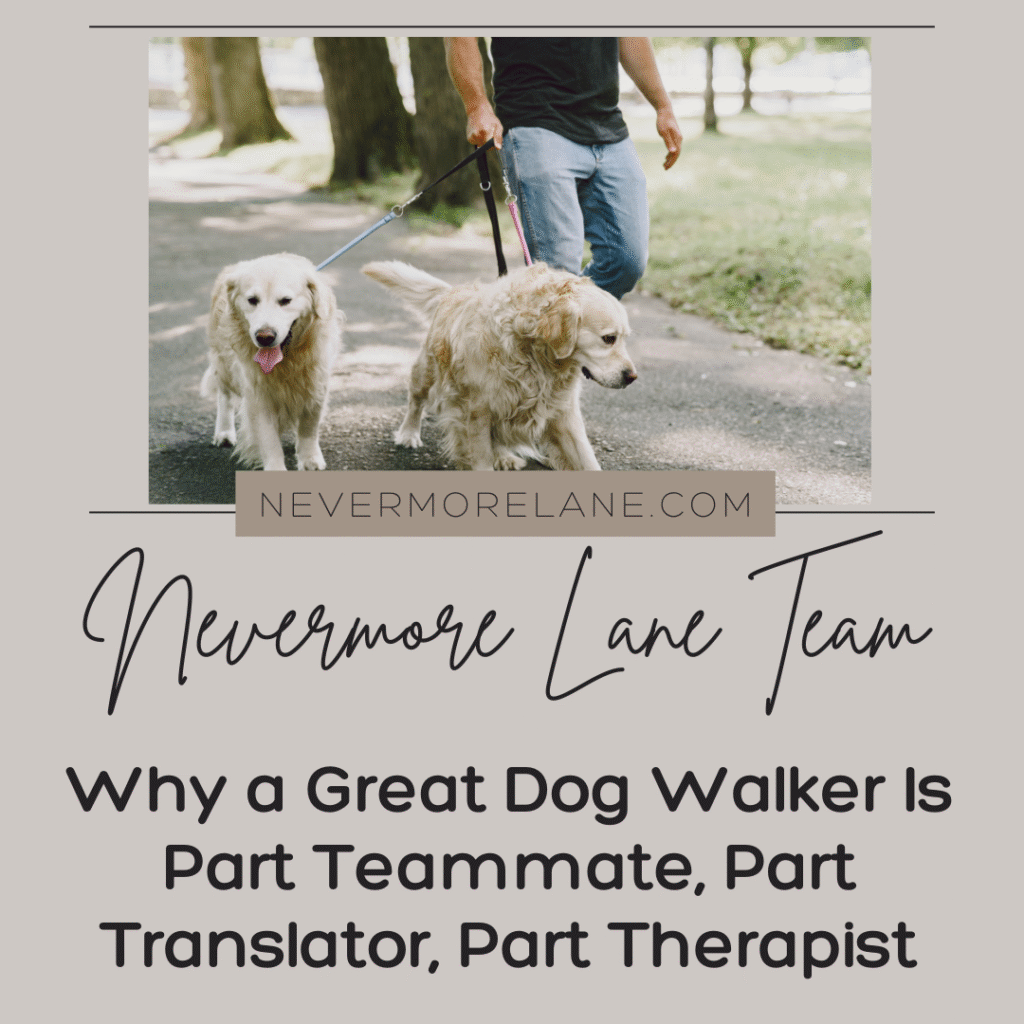Why a Great Dog Walker Is Part Teammate, Part Translator, Part Therapist
The right dog walker becomes an invisible member of the household, someone trusted with keys, alarm codes, and the wellbeing of a family member who cannot speak for themselves. In large cities like Chicago, Detroit, Dallas, streets, walks meet buses, delivery bikes, and restaurant patios; owners often depend on walkers who read signals, keep steady pacing, and keep notes on reactions. Those details matter when sidewalks compress and schedules are tight.
Finding this person feels impossibly difficult because the job description extends far beyond simply clipping a leash and walking around the block for twenty minutes. Great dog walkers read canine body language fluently, communicate observations that owners miss, provide emotional support during separation anxiety, and become partners in maintaining the dog’s physical health and mental happiness. The bond between exceptional dog walkers and their canine clients rivals the relationships dogs form with their own families.
Most dog owners discover the profound difference between adequate and exceptional dog walkers only after experiencing both. Adequate walkers show up on time, complete the required distance, and leave without incident. Exceptional walkers notice the slight limp that signals a developing injury, recognize early signs of illness before symptoms become obvious, understand which dogs make good walking companions and which create stress, and communicate observations that help owners make better care decisions. They decode barking patterns, identify triggers for reactive behavior, celebrate small training victories, and mourn alongside families when senior dogs decline. These individuals transform what seems like a simple service into genuine caregiving partnership.
The multi-dimensional role great dog walkers play encompasses skills that no job posting fully captures. They translate canine communication into human understanding, collaborate with owners on training consistency and behavioral goals, provide emotional support to anxious dogs navigating daily separations, and deliver peace of mind to working families who entrust their beloved companions to someone else’s care. Understanding why exceptional dog walkers become indispensable teammates rather than replaceable service providers reveals the depth of relationship possible when the right person connects with both dog and owner.
Collaboration Starts With Connection
Shared digital records keep owners, walkers, and pets aligned on routines and expectations. As one 5-star rated Chicago dog walking service puts it, “licensed, insured and GPS tracking—just a few reasons to choose us,” which shows the care and dedication that define professional pet services in a busy city like Chicago. Logging walk times, GPS routes, leash behavior, and incident notes makes patterns visible and reduces conflicting cues. When teams agree on triggers, preferred pacing, and how to respond to pulls or freezes, the dog experiences consistent feedback across caregivers.
Monthly check-ins allow small adjustments to routing, timing, and reinforcement so habits don’t drift. Walkers who mirror owner cues for sit, eye contact, or leash length reduce confusion and speed learning, and sharing short video clips or voice notes helps owners align home practice, keeping the dog’s experience steady as circumstances change.
Translating Behavior Into Clarity
Street-level stimuli such as scooters, delivery bikes, and crowded patios often change a dog’s posture, sniffing, and pace. Great walkers watch for repeated reactions, log timing and context, and translate those observations into clear, actionable notes for owners. Tracking whether a dog pulls toward noises or freezes at doorways identifies patterns that help shape safer, calmer outings.
Walkers who adjust routes to avoid high-traffic blocks or add extra sniff breaks lower stress and improve predictability. Clear summaries should state triggers, calming techniques used, and home strategies owners can try, with simple examples where helpful. That level of communication makes it easier for owners to respond confidently and keep progress steady.
Emotional Grounding in the City
Consistent routines help dogs stay calmer in Chicago’s bustle. A walker who uses measured pace, planned sniff breaks, and quiet-sidewalk paths gives a dog space to collect itself after noisy intersections and crowded blocks. Those choices reduce spikes in arousal, lower reactive responses, and let the animal settle back into regular breathing and movement patterns.
Handlers who model calm energy while choosing quieter routes and brief stops at green pockets make it easier for dogs to self-regulate. Tracking when a dog relaxes during low-stim segments and sharing those observations with owners helps refine home routines. Small adjustments to timing or leash length can make afternoons less stressful, so owners know which practices to try next.
Communication That Builds Trust
Clear daily updates give owners confidence when they can’t be there. Reliable systems that share walk summaries, including GPS tracks and concise behavioral notes, make activities transparent and searchable. Timely photos or short voice clips add context, making it easier to spot small trends in appetite, gait, or social responses before they become bigger issues.
Spotting minor shifts in energy or mood and reporting them promptly builds confidence that the walker is attentive. An agreed window for live messages during work hours makes route tweaks or schedule swaps simple and fast, which keeps routines intact and deepens owner trust while making it easy to coordinate care beyond the walk.
Care That Extends Beyond the Walk
Monitoring water intake and energy levels gives owners clear, usable signals about their pet’s day. Walkers note panting, rest length, and play intensity, then send concise updates so owners can adjust feeding, schedule a vet check, or change evening activity. Small photo timestamps add quick context.
Consistent routines and familiar handling make walkers into predictable, calming figures for anxious dogs. Using the same arrival cues, leash adjustments, and pacing helps dogs learn what to expect, which cuts down on pull and pacing at home. Regular feedback to owners about calming cues strengthens the bond so owners feel secure and understood, and over weeks this steady presence reduces daily friction.
When Trust Becomes Partnership
Great dog walkers earn their place as teammates through consistency, observation, and genuine care that extends beyond transactional service. They notice subtle changes in energy, appetite, and behavior that signal health issues before they escalate. They adapt walks to match each dog’s needs rather than following rigid routines. They celebrate quirks and personalities instead of demanding conformity. This individualized attention creates trust that benefits everyone involved.
The translator role emerges through fluency in canine body language and communication patterns. Tail position, ear placement, facial expressions, and vocalization all convey specific meanings that skilled walkers interpret accurately. They recognize the difference between playful excitement and anxious overstimulation. They identify fear versus aggression. They understand when dogs need space versus when they crave interaction. These interpretive skills prevent problems and enhance wellbeing.
The therapist dimension appears in how exceptional walkers provide emotional stability for dogs experiencing separation anxiety, help nervous dogs build confidence, and offer companionship that enriches lives beyond physical exercise. They become safe people in the dog’s world. Trusted friends who show up reliably. Sources of joy and adventure during long workdays. The bond formed through daily walks creates relationships that matter deeply to dogs who live for these outings and the people who make them special.






